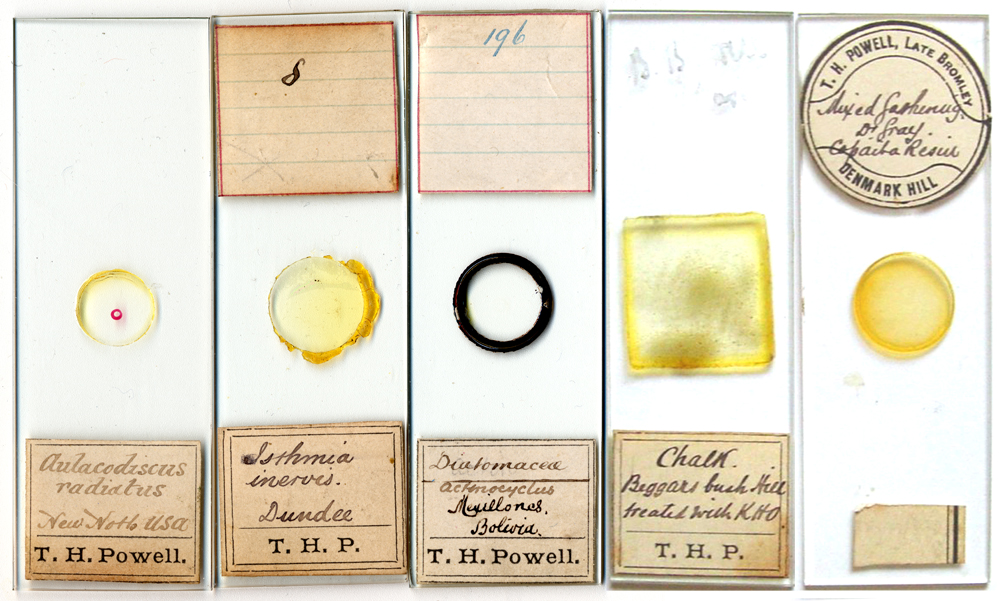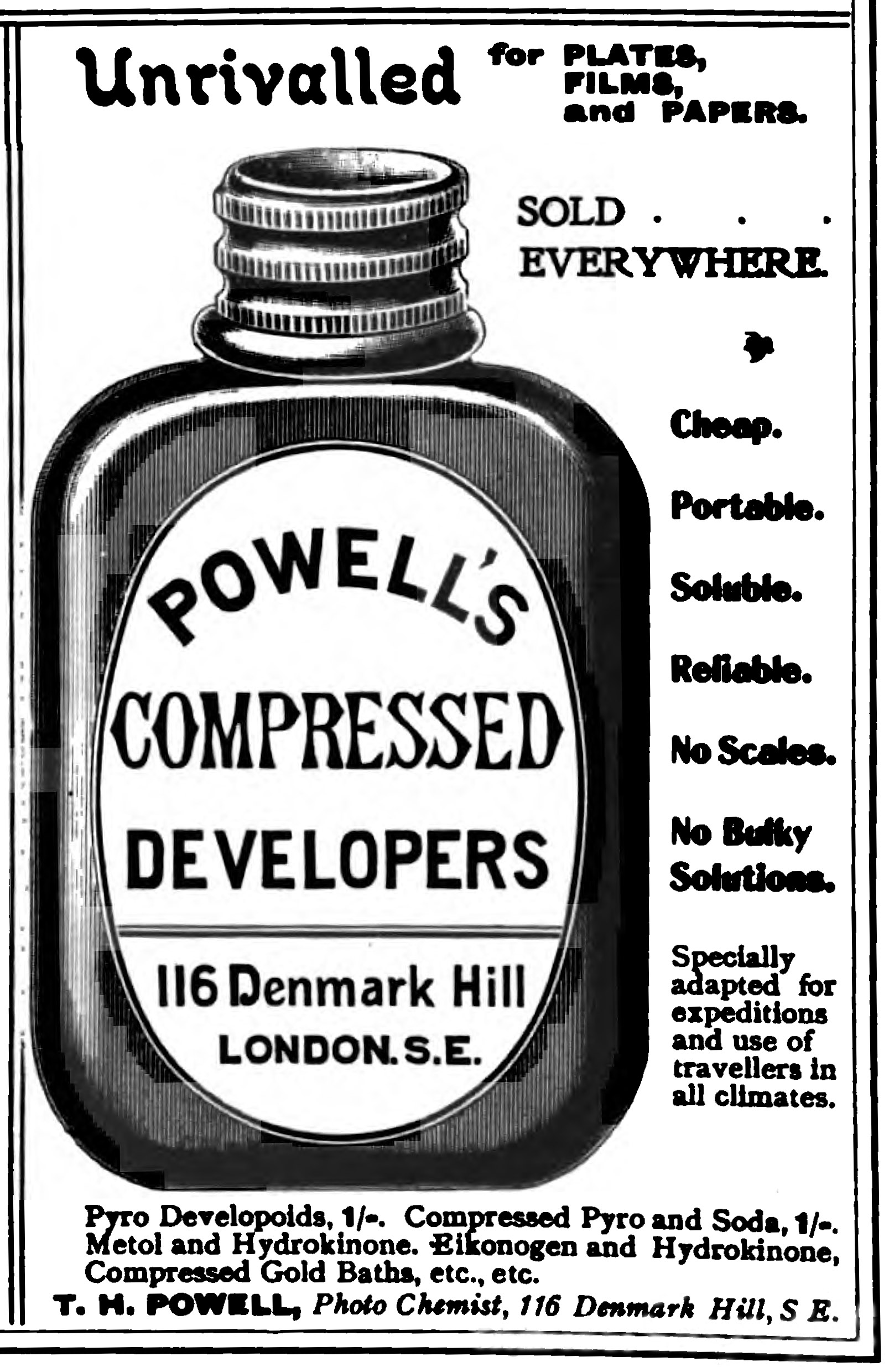
Thomas Henry Powell, microscopist (1851-1932)
Brian Stevenson, Kentucky, USA
Antique microscope slides bearing the name “T.H. Powell” or the initials “T.H.P.” are occasionally encountered at auction or in collections. The specimens are usually diatoms. Brian Bracegirdle, writing in Microscopical Mounts and Mounters, attributed these slides to Thomas Hugh Powell, son of Hugh Powell (of Lealand and Powell fame). However, a rare T.H. Powell microscope slide has come to light, which demonstrates that these slides were not made by Thomas Hugh Powell. The Denmark Hill address on the rightmost slide of Figure 1 does not correspond with any known address of that man. It was, however, the address of Thomas Henry Powell. The two men were not related to each other. However, they did know each other, as both were members of the Quekett Microscopical Club. Thomas Henry joined on July 24, 1874, and remained a member through 1881. Thomas Hugh joined the QMC in 1865, and the Royal Microscopical Society in 1880. Published RMS reports of Thomas Hugh Powell refer to him as “Mr. T.H. Powell”, while QMC records usually refer to him as “Mr. T. Powell”. Thomas Henry Powell was referred to in QMC records as “Mr. T.H. Powell”. For the most part, QMC records note “Mr. T. Powell” (Thomas Hugh) as exhibiting microscope lenses (consistent with his microscope-producing business), while “Mr. T.H. Powell” (Thomas Henry) generally exhibited diatoms or pharmaceutical agents.

Figure 1. Examples of microscope slides produced by T.H. Powell. The address of the rightmost slide confirms that the maker was Thomas Henry Powell. Powell moved from Poultry Street to Denmark Hill during 1879. Thus, the rightmost slide dates from that year or later, while the other four slides probably date from before 1879.
Thomas Henry Powell was born in Islington (now London) in late 1851, the first child of John and Mary Ann Powell. Father John was recorded on the 1861 census as being a “landed proprietor”. At the time of the next census, in 1871, 19 year old Thomas was an apprentice chemist, living with pharmacist John Broad and his family in Islington. Thomas qualified as a pharmacist in July 19, 1872. He shortly thereafter operated a chemist’s shop at 7 Poultry St.. During 1879, Powell moved his home and shop to 116 Denmark Hill, Lambeth, London. The 1881 census recorded Thomas as the head of household, along with three unmarried younger brothers, a chemist’s assistant and a housekeeper. At the end of 1882, Thomas married Ida Thrower. Their first child, John Henry, had been born earlier that year.
As noted above, Thomas Henry Powell joined the Quekett Microscopical Club in 1874. Among the various microscopical objects he exhibited at club functions were: “section of stem of Jaborandi” (a medicinal herb, on Dec. 10, 1875), “iodo-sulphate of quinine” (Nov. 24 1876), “spores of Equisetum” (April 13, 1877), “Aulacodiscus jutlandicus, from the Cementstein Mors, Jutland” (May 25, 1877), “collection of Aulisci” (June 8, 1877), “Aulacodiscus anaenus (from Moron)” (Dec. 28, 1877), “crystals from opium liniment” (March 22, 1878), and “fossil teeth from Bristol bone bed – Lyme Regis” (Sept. 27, 1878). Powell resigned from the QMC after 1881, likely due to increased time commitments at home from his new marriage and child. I did not locate any further records of an involvement in club microscopy.
Further evidence of Thomas Henry Powell’s interest in diatoms is an exchange offer he published during 1876 in the popular magazine Hardwicke’s Science-Gossip (Figure 2).

Figure 2. An exchange offer from Thomas Henry Powell, Hardwicke’s Science-Gossip, 1876.
On March 28, 1879, “Mr. T.H. Powell” exhibited to the QMC “Pleurosigma angulatum, shown with an oil immersion 1/8 objective”. The detailed description of the lens probably means that this exhibit was provided by Thomas Hugh Powell, the microscope lens maker. This is consistent with other exhibits attributable to Thomas Hugh Powell, where the lenses were described in greater detail than were the specimens being displayed. In contrast, exhibits attributable to Thomas Henry Powell described only the specimen, and never the lens or microscope.
Powell also had a strong interest in photography (Figure 3). In 1876, he published a two-page article in Hardwicke’s Science-Gossip entitled “Photo-Micrography”. Donations to the Quekett Microscopical Club in 1878 included “a photograph of the grave of the late Professor Quekett … presented by Mr. T.H. Powell”. Powell exhibited “photographs” at the 1879 QMC annual Conversazione. Powell’s chemist shop advertised a wide variety of photography chemicals (e.g. Figure 4). He issued at least one catalogue of photographic chemicals and developing equipment, in 1896.

Figure 3. Photograph prints by Thomas Henry Powell, illustrating the effects of various developing processes on print clarity. From The Photogram, 1902, Vol. 9, pages 356-357.

Figure 4. Advertisement for photographic chemicals by Thomas Henry Powell, from Photograms of the Year 1899.
By the 1890s, Powell had also developed an active interest in paleontology, which he often combined with his enthusiasm for photography and microscopy. An 1897 article in Natural Science on “The Authenticity of Plateau Man” include the note “for photographs I must express my indebtedness to Mr. T.H. Powell of Denmark Hill”.
Mrs. M.E. Cunnington, writing in 1907 on the opening of a bronze age barrow (grave mound) in The Wiltshire Archaeological and Natural History Magazine reported ”On removing the bones it was noticed that the ground immediately beneath the skeleton and about the head was stained a reddish colour. Dr. C.W. Cunnington, of Hampstead, has kindly analysed the incrustation and finds it to be the hydratio peroxide of iron. Mr. T.H. Powell, of Denmark Hill, to whom also a specimen was submitted, has kindly reported as follows: ‘I have examined the red stain under the microscope and can detect signs of wood structure, and think, therefore, the rest has completely decayed, except where the tissue has been replaced by iron rust; it might be all that is left of a flaxen garment, but I managed to detach one or two small fragments which are rather too thick. Iron oxide has the property of replacing, and thus coarsely preserving wood and such like tissue (vegetable) and often forms a sort of cement. The stain is iron oxide. I have tested it chemically. If the barrow was on top of the chalk, the clay would certainly be highly ferrugineous, and the stain might very probably have been derived direct from the chalk.’ The wood fibre detected by Mr. Powell came from about the head, and his report thus satisfactorily accounts for the red incrustation ; the vegetable fibre of the garment round the body (linen) and the wood about the head had been to some extent replaced by iron oxide from the surrounding clay, thus forming a layer or incrustation of red colour.”
In 1945, W.J. Arkell, wrote on Palaeoliths from the Wallingford Fan gravels for Oxoniensia, and described several stone age axes and archaeological discoveries of “the late T.H. Powell of Denmark Hill”.
The Ashmolean Museum at Oxford holds a large collection of archaeology-related letters between Thomas Henry Powell and Percy Manning.
Powell sold his chemist’s business to Frederick Atkinson in 1923. He died at the age of 80, in 1932.
Comments to the author will be welcomed.
Author’s note: This and other historical microscopists’ biographies can also be seen at http://microscopist.net
Acknowledgement
Many thanks to Peter Hodds for providing images of Thomas Henry Powell’s microscope slides.
Resources
Arkell, W.J. (1945) Palaeoliths from the Wallingford Fans gravel, Oxoniensia, Vols. 8-9, pages 1-18.
Ashmolean Museum, Oxford, Percy Manning archive: http://www.ashmolean.museum/ash/amps/oha/ArchivePages/Archives.html
Bracegirdle, Brian (1998) Microscopical Mounters and Mounters, Quekett Microscopical Club, London.
Chemist & Druggist (1887) Corn solvent, Vol. 30, page 515.
Cunnington, Mrs. M.E. (1907) Notes on the opening of a bronze age barrow at Manton, near Marlborough, Wiltshire Archaeological and Natural History Magazine, Vol. 35, pages 1-20.
Cunnington, William (1897) The authenticity of Plateau Man, Natural Science, Vol. 11, pages 327-333.
England census, birth, marriage and death records, accessed through ancestry.co.uk
Hardwicke’s Science-Gossip, (1876) Exchange offer, Vol. 12, page 168.
Journal of the Quekett Microscopical Club (1875) Various exhibits by T.H. Powell, Vol. 4, pages 131, 164-166, 195-197, and 238-240.
Journal of the Quekett Microscopical Club (1876) Various exhibits by T.H. Powell, Vol. 4, pages 294-300, and 328-331.
Journal of the Quekett Microscopical Club (1876) List of Members, Vol. 4.
Journal of the Quekett Microscopical Club (1877) Various exhibits by T.H. Powell, Vol. 5, pages 13-16, and 26-28.
Journal of the Quekett Microscopical Club (1878) Various exhibits by T.H. Powell, Vol. 5, pages 70-72, and 137-140.
Journal of the Quekett Microscopical Club (1879) Report of the Annual Conversazione, Vol. 5, pages 198-205.
Journal of the Quekett Microscopical Club (1879) Ordinary Meeting, March 28 Vol. 5, pages 205-208.
Journal of the Quekett Microscopical Club (1881) List of Members, Vol. 6.
Journal of the Quekett Microscopical Club (1882) List of Members, Vol. 1, series 2.
The National Archives, Agreement for sale of business of pharmacist and chemist at 116 Denmark Hill, London SE5, by T. H. Powell of London to Frederick Atkinson of New Barnet, MS 3375/1771, 1923, http://www.nationalarchives.gov.uk/A2A/records.aspx?cat=143-ms3375_1-1&cid=-1&Gsm=2008-06-18 - -1
Pharmaceutical Journal (1877) List of Subscriptions and Donations to the Benevolent Fund received during the months of September and October, 1877, Third series, Vol. 8, page 351.
Pharmaceutical Journal (1888) List of Pharmacists that were requested to file with the Registrar, Vol. 19, page 393.
Pharmaceutical Journal (1907) Letters, Vol. 78, page 684.
The Photogram (1894) Advertisement from T.H. Powell, Vol. 1, pages 115 and 221.
The Photogram (1896) Note on catalogue from T.H. Powell, Vol. 3, page 128.
The Photogram (1902) On certain practical methods in P.O.P. printing, Vol. 9, pages 356-357.
Photograms of the Year (1896) Advertisement from T.H. Powell.
Photograms of the Year (1896) Advertisement from T.H. Powell, page lxxxiii.
Photography for Novices, the Primus Handbook (1902), Advertisement from T.H. Powell, page xii, W Butcher & Sons, Camera House, St. Bride St. EC, and Blackheath.
Powell, Thomas Henry (1876) Photo-micrography, Hardwicke’s Science-Gossip, Vol. 12, pages 59-60.
Powell, Thomas Henry (1877) Cleaning glass slides, Hardwicke’s Science-Gossip, Vol. 13, pages 276-277.
Powell, Thomas Henry (1879) Intelligence in man and animals, Hardwicke’s Science-Gossip, Vol. 15, page 279.
The Registers of Pharmaceutical Chemists and Chemists and Druggists (1885) Pharmaceutical Society of Great Britain, page 20.
Microscopy UK Front
Page
Micscape
Magazine
Article
Library
Published in the October 2010 edition of Micscape Magazine.
Please report any Web problems or offer general comments to the Micscape Editor .
Micscape is the on-line monthly magazine of the Microscopy UK website at Microscopy-UK .
© Onview.net Ltd, Microscopy-UK, and all contributors 1995 onwards. All rights reserved. Main site is at www.microscopy-uk.org.uk .